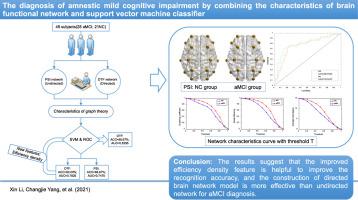Journal of Neuroscience Methods ( IF 2.7 ) Pub Date : 2021-08-21 , DOI: 10.1016/j.jneumeth.2021.109334 Xin Li 1 , Changjie Yang 1 , Ping Xie 2 , Ying Han 3 , Rui Su 1 , Zhenyang Li 1 , Yi Liu 1

|
Background
Amnestic mild cognitive impairment (aMCI) is an essential stage of early detection and potential intervention for Alzheimer’s disease (AD). Patients with aMCI exhibit partially abnormal functional brain connectivity and it is suggested that these features may represent a new diagnostic marker of early AD.
New method
In this paper, we constructed two brain network models, a phase synchronization index (PSI) undirected network and a directed transfer function (DTF) directed network, to evaluate the cognitive function in patients with aMCI. We then built SVM classification models using the network clustering coefficient, global efficiency and average node degree as features to distinguish between aMCI patients and controls.
Results
Our results reveal a classification accuracy and AUC of 66.6 ± 1.7% and 0.7475 and 80.0 ± 2.2% and 0.7825, respectively, for the two network models (PSI and DTF). As the directed network model performed better than the undirected model, we introduced an improved graph theory feature, efficiency density, which resulted in an increased classification accuracy and AUC value 86.6 ± 2.6% and 0.8295, respectively.
Comparison with existing methods
The analysis of network models and the directionality of information flow is suitable for analysis of nonlinear EEG signals for assessment of the functional state of the brain. Compared with traditional network features, our proposed improved features more comprehensively evaluate transmission efficiency and density of the brain.
Conclusion
In this study, we demonstrate that an improved efficiency density feature is helpful for enhancing classification the accuracy of aMCI. Moreover, directed brain network models exhibit better classification for aMCI diagnosis than undirected networks.
中文翻译:

结合脑功能网络特征与支持向量机分类器对遗忘型轻度认知障碍的诊断
背景
遗忘性轻度认知障碍 (aMCI) 是早期发现和潜在干预阿尔茨海默病 (AD) 的重要阶段。aMCI 患者表现出部分异常的功能性脑连接,这表明这些特征可能代表早期 AD 的新诊断标志物。
新方法
在本文中,我们构建了两个脑网络模型,相位同步指数(PSI)无向网络和有向传递函数(DTF)有向网络,以评估 aMCI 患者的认知功能。然后,我们使用网络聚类系数、全局效率和平均节点度数作为特征来构建 SVM 分类模型,以区分 aMCI 患者和对照。
结果
我们的结果显示,两种网络模型(PSI 和 DTF)的分类准确度和 AUC 分别为 66.6 ± 1.7% 和 0.7475 以及 80.0 ± 2.2% 和 0.7825。由于有向网络模型比无向模型表现更好,我们引入了改进的图论特征、效率密度,从而提高了分类精度和 AUC 值,分别为 86.6 ± 2.6% 和 0.8295。
与现有方法的比较
网络模型的分析和信息流的方向性适用于非线性脑电信号的分析,以评估大脑的功能状态。与传统的网络特征相比,我们提出的改进特征更全面地评估了大脑的传输效率和密度。
结论
在这项研究中,我们证明了改进的效率密度特征有助于提高 aMCI 的分类精度。此外,与无向网络相比,有向脑网络模型对 aMCI 诊断表现出更好的分类。











































 京公网安备 11010802027423号
京公网安备 11010802027423号